Why are pollinators important?
Pollinators are animals that transfer pollen from one plant to another either by accident or on purpose, helping the plant produce seeds and thus reproduce. Pollination is usually incidental and occurs when pollen grains are carried and dropped as pollinators move among flowers. Some pollinators, though, have more of a direct purpose, like female bees who aim to collect as much pollen as possible to feed more bee larvae. Pollinators make food growth possible, sustain our food webs and ecosystems, and produce our natural resources all by helping plants reproduce.
Types of pollinators
Bees
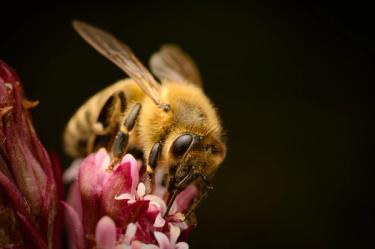
With over 4,000 bee species native to North America, this group of pollinators is probably the one that comes to mind when you think of pollination. Although honey bees are most popular, there are many different types of bee pollinators. Some are social species like bumble bees, while others like miner bees are solitary, meaning there is no queen and each female lays her own eggs. Not all bees produce honey either, and there are differences in the size of their colonies.
How they pollinate
- Bumble bees perform “buzz pollination” where they grip a flower in their jaws and vibrate their wings to get the pollen. They are also able to fly in cooler temperatures and lower light levels making them great pollinators at higher elevations and latitudes.
What they look for
- White, purple and yellow flowers like mints (Lamiaceae), sunflowers (Asteraceae), and bellflowers (Campanulaceae)
- Long-tongued bees, like those in the Apidae and Megachilidae families, prefer tubular flowers like penstemon
- Short-tongued bees, like miner bees in the Andrenidae family, like flowers with shallow florets like sunflowers
Butterflies
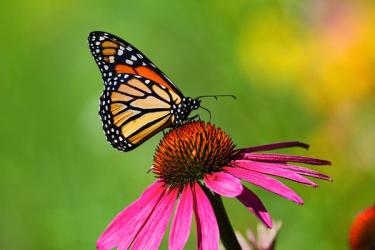
There are over 800 native species in North America like the tiger swallowtail and orange sulfur butterflies. Most co-evolved with a specific host plant meaning that young caterpillars only eat one kind of plant to become adults, like the monarch butterfly and milkweed. Some butterflies migrate or travel long distances for survival or food sources, most notably the monarch butterfly which can migrate from Canada to Mexico.
How they pollinate
- Butterflies seek out the nectar from flowers they visit. They use their long tongue, or proboscis, to drink the sugary liquid and in the process get pollen on them, which they carry onto the next flower.
What they look for
- Bright colored flowers like milkweed, mints, sunflowers, and bellflowers
- Flowers with “landing pads” or flat tops
- Sunny areas to bask in
Fun Fact: Brightly colored butterflies, like the monarch, use flashy colors like red and orange to ward off predators like birds. They may be distasteful or toxic to eat or some species are just pretending to be by mimicking the coloration of toxic species.
Moths
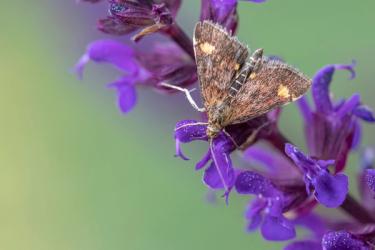
Butterflies and moths are closely related, but there are many more moth species than butterfly species. North America alone has over 11,000 native moth species including the luna moth (Actias luna), cecropia moth (Hyalophora cecropia), and galium sphinx moth (Hyles gallii). Some moths have neutral or muted colors that may be easy to overlook, but don’t underestimate their importance as pollinators and vital players in the food web.
How they pollinate
- These nocturnal pollinators usually fly at night and pollinate night-blooming plants.
- Like butterflies, moths seek out the nectar from flowers they visit but also like tree sap or rotting fruit in some cases.
What they look for
- Flowers open at night like some flowers from the primrose/sundrop (Oenothera), lily (Lilium) and morning glory (Ipomoea) genera
- Pale pink, green, and white flowers with strong scents
- Showy tubular flowers like lobelias or penstemons
Birds
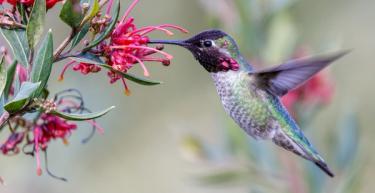
The most common nectar-pollinating birds include hummingbirds, spiderhunters, sunbirds, honeycreepers, and honeyeaters. While some birds pollinate wildflowers, other native species to North America like the wood thrush, cerulean warbler, and yellow-billed cuckoo provide a critical function of seed dispersal for plants too. Instead of feeding solely on nectar, they help to pollinate, or rather naturally disperse, berries, fruits, and seeds.
How they pollinate
- Birds use their bills to feed on nectar and other plant materials, so they transfer pollen as they fly from flower to flower.
- The seeds, berries, and fruit that native species feed on travel through their digestive tract to properly germinate and grow.
What they look for
- Tubular flowers that have tubes, funnels, cups, or curved petals for easier access to deeply hidden nectar like the trumpet vine and trumpet honeysuckle
- Bright colors of red, yellow, or orange like bee balm and rhododendron
- Native shrubs like dogwoods, elderberry, serviceberry, chokecherry, hazelnut, witch hazel, roses, and viburnums
- Odorless, since birds have a poor sense of smell
Fun Fact: Hummingbirds, like the native ruby-throated hummingbird, only weigh a few grams, but they eat several times their weight each day to support their heart that pumps 1,200 times per minute and wings that beat seventy times every second.
Bats
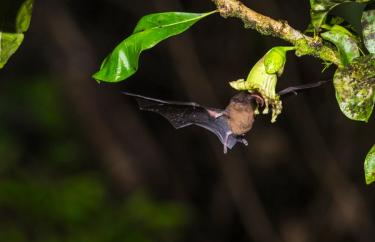
There are 45 species of bats native to North America like the lesser long-nosed bat (Leptonycteris curasoae) and Mexican long-tongued bat (Choeronycteris mexicana). Over 300 species of fruit depend on bats for pollination including mangoes, bananas, and guavas. In southwestern deserts, bats are the key pollinators of saguaro and organ pipe cactus, and even agave (which is fermented to make tequila).
How they pollinate
- Like moths, bats are nocturnal pollinators. They fly at night, drink nectar from flowers and pollinate night-blooming plants as pollen sticks to their body hairs.
What they look for
- Large flowers that produce a lot of nectar and are open at night like some flowers from the following genera: primrose/sundrop (Oenothera), lily (Lilium) and morning glory (Ipomoea)
- Pale or white colors
- Strong scents like musty or rotten odors
Fun Fact: New England bats are insectivores (meaning they eat insects), not frugivores which eat mostly fruits, and are thus not pollinators.
Beetles
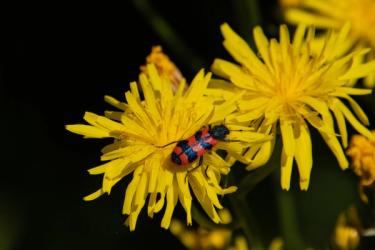
Believe it or not, beetles make up the largest and most diverse group of animals in the world! There are over 25,000 species in North America like the Colorado plains soldier beetle (Chauliognathus basalis) and locust borer beetle (Megacyllene robiniae), and over 350,000 species worldwide. Beetles were some of the first insects to pollinate flowering plants as far back as 200 million years ago.
How they pollinate
- They pollinate as pollen grains stick to their bodies as they move from flower to flower.
What they look for
- Strong fruity or decaying scents as they rely on their sense of smell to find food and places to lay their eggs
- White, to dull white or green colors
- Landing pads: large flat flowers or flower clusters like goldenrod or spicebush
Wasps
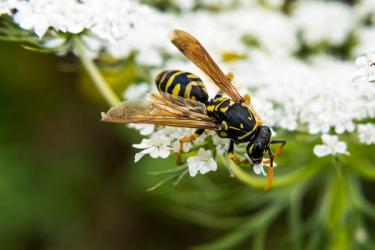
Wasps are related to bees, but most live solitary lives. They get a bad reputation for being aggressive, but in addition to being important pollinators, they are very valuable at keeping insect and pest populations in balance like grasshoppers in your lawn. There are about 18,000 native species to North America including the northern paper wasp (Polistes fuscatus), common thread-waisted wasp (Ammophila procera), and blue mud wasp (Chalybion californium).
How they pollinate
- Many wasps are smooth-bodied without pollen-trapping hairs and do not actively collect pollen. But they do provide some incidental pollination, carrying and dropping some pollen grains as they move among flowers.
What they look for
- Shallow blooms for their short tongues like asters and goldenrod
- White and yellow blooms, since they can’t see red color but can see UV light
- Sweet fruits or flowers with a lot if nectar
Flies
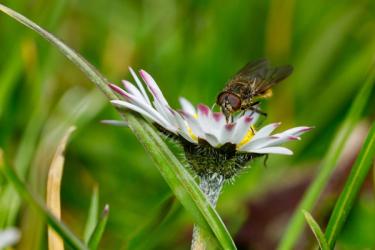
This incredibly diverse group of insects includes about 16,000 native species like the syrphid fly (Sphaerophoria philanthus), tachinid fly (Archytas apicifer), and green bottle fly (Lucilia sericata). Flies were among the earliest pollinators to emerge, so they’re paired with the earliest-blooming native flowers like the skunk cabbage and papaw. Flies are responsible for pollinating spices like coriander, caraway, and fennel as well as onions, carrots, mangos, and chocolate! Beyond their importance as pollinators, flies are natural pest control for common garden pests like aphids, scales, thrips, and caterpillars.
How they pollinate
- Flies visit flowers to sip on the nectar, and end up incidentally carrying pollen from one flower to the next.
What they look for
- Large, flat, pale flowers
- Flowers with unappealing smells to humans (think rotting meat, carrion, dung, humus, sap, and blood) like jack-in-the-pulpit (Arisaema triphyllum), pawpaw (Asimina triloba), skunk cabbage (Symplocarpus foetidus), and red trillium (Trillium erectum)
Fun Fact: Many flies like the margined calligrapher fly (Toxomerus marginatus) are bee mimics. To tell them apart, remember that flies have one pair of wings and bees have two pairs of wings.
How you can help pollinators
Pollinators around the world are facing threats leading to their decline. Habitat loss, reduced species diversity, excessive or improper insecticide and pesticide application, forage availability, and timeline disruption due to changing climatic patterns are all causes to the trend, but there are many ways you can help:
- Create pollinator habitat. Introduce true native and pollinator friendly plants like wildflowers, shrubs, and trees. Provide habitat with bird houses, bee hotels, and butterfly habitat. Add a water source, making sure they are shallow enough areas, and a heat source like flat rocks in the sun.
- Opt for a pesticide-free garden and backyard or try to limit your use of pesticides and insecticides, making sure to never apply to flowering plants.
- Decrease light pollution, especially during spring migration (April–May) and fall migration (August–September).
- Support migration efforts for birds and butterflies.
Cited sources
About pollinators. Pollinator Partnership.
Gardening for moths. Xerces Society.
Insects that look like bees. Michigan State University Extension.
Pollinators. University of Maryland Extension.
Pollinators. USFWS.
Power of pollinators. Forest Preserve District of DuPage County.
Who are the pollinators? University of New Hampshire Extension.
Who are the pollinators? Xerces Society.











